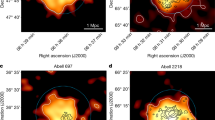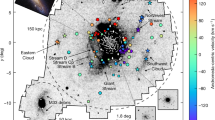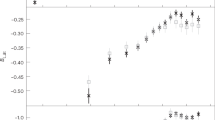Abstract
(1) THE determination of the past duration of solar radiation, and, consequently, the problem of the age of the inhabitable earth, imposes upon theories of radiation a difficulty the magnitude and fundamental importance of which appear to be too infrequently considered. The difference in the time-scales derived from the gravitational theory of solar energy and from geological and astronomical observation is not one of a few per cent. (or less) of the basic quantities involved, as is generally the case with the discrepancies that have led to conspicuous modifications of radiation theories; the discrepancy is rather a matter of a hundred to one, or even of a thousand or more to one. A more glaring disagreement could scarcely be imagined between a generally accepted and thoroughly workable theory on one hand, and, on the other, a mass of observation now too extensive and varied to be denied and some equally formidable physical laws.
This is a preview of subscription content, access via your institution
Access options
Subscribe to this journal
Receive 51 print issues and online access
$199.00 per year
only $3.90 per issue
Buy this article
- Purchase on Springer Link
- Instant access to full article PDF
Prices may be subject to local taxes which are calculated during checkout
Similar content being viewed by others
References
Vol. xcv., pp. 203, 372 (1915).
Vol. xcix., p. 444 (1917).
Vol. xcix., p. 445 (1917).
Loc. cit. and Monthly Notices, vol. lxxvii., p. 611 (1917).
Cf. general discussion in Publ. Ast. Soc. Pac., vol. xxx., p. 283 (1918).
Mt. Wilson Contr., No. 157 (1918).
Cf. Charlier, Observatory, vol. xl., p. 390 (1917); Jeans, ibid., p. 406. A much smaller stellar system was considered by Charlier and Jeans than is now under consideration.
Publ. Ast. Soc. Pac., vol. xxx., p. 54 (1918); Mt. Wilson Contr., No. 157, p. 14 (1918).
Monthly Notices, vol. lxxvii., pp. 610, 612 (1917).
Mt. Wilson Contr., No. 151, p. 16 (1917).
NATURE, vol. xcix., p. 308 (1917); Monthly Notices, vol. lxxvii., pp. 16, 596 (1916, 1917).
Monthly Notices., vol. lxxviii., p. 36 (1917).
Mt. Wilson Contr., No. 154. p. 6 (1917)
Observatory, vol. xli., p. 379 (1918).
Cf. analysis by Luizet, Annales de l'Universite de Lyon, N.S., i. fascicule 33 (1912).
Bull. Geol. Soc. of Amer., vol. xxviii., pp. 745–904 (1917).
"The Evolution of the Earth and its Inhabitants" (New Haven, 1918); chap. ii.
"Electricity and Matter" (London 1904), and elsewhere.
Proc. Nat. Acad. Sci., vol. iv., p. 140 (1918); the Messenger of Mathematics, N.S., vol. xlvii., p. 161 (1918); Phil. Mag., vol. xxxiv., p. 405 (1917). The more extended statement of the theory will appear in the Proceedings of the London Mathematical Society.
Sir J. J. Thomson, Proc. Cambr. Phil. Soc., vol. xiv., p. 419 (1907). Cf. Jeans, "Report on Radiation and the Quantum-Theory" (London, 1914). pp. 81, 85 ff.
The angle subtended by the large nebulas much exceeds that of stars and planets, but it is very unlikely that the nebulae represent a continuous distribution of matter.
Mt. Wilson Communications, Nos. 19 and 34 (1916), and elsewhere.
Eddington, NATURE, vol. xcix., p. 445 (1917).
[December 28.] Father Rodés has pointed out to me that Poincaré", in a discussion of the impossibility of regarding the sun as a cooling body entirely without power of renewing its heat ("Hypothèses Cosmogoniques," p. 192), refers to the "solid angle" hypothesis, rejecting it, however, for the reason (which in the present problem does not now appear sufficient) that "at the moment when energy leaves the sun it obviously cannot foretell whether or not it will encounter a planet." Poincaré did not consider the discrepancy very serious between geology and the contraction theory, apparently believing that radio-activity would be competent to make up whatever defic of energy might exist.
Author information
Authors and Affiliations
Rights and permissions
About this article
Cite this article
SHAPLEY, H. Globular Clusters, Cepheid Variables, and Radiation. Nature 103, 25–27 (1919). https://doi.org/10.1038/103025c0
Issue Date:
DOI: https://doi.org/10.1038/103025c0
Comments
By submitting a comment you agree to abide by our Terms and Community Guidelines. If you find something abusive or that does not comply with our terms or guidelines please flag it as inappropriate.



